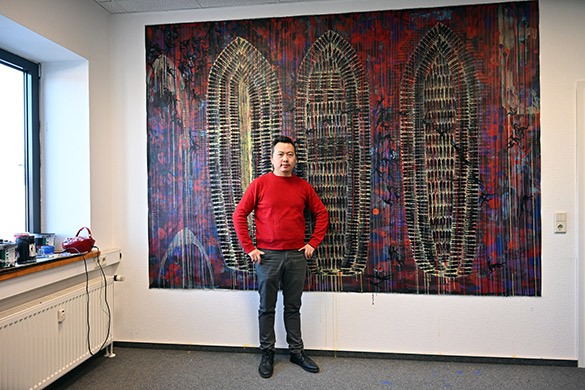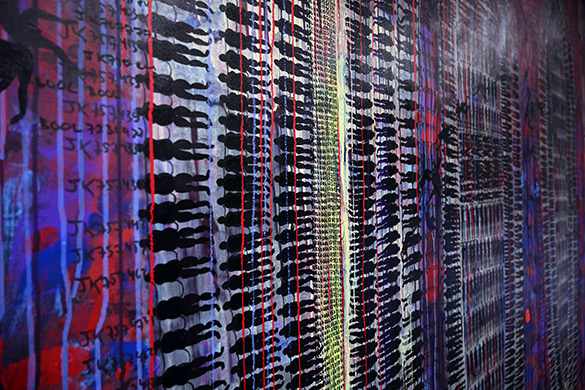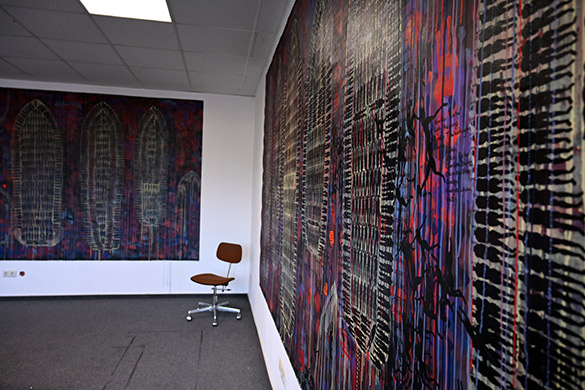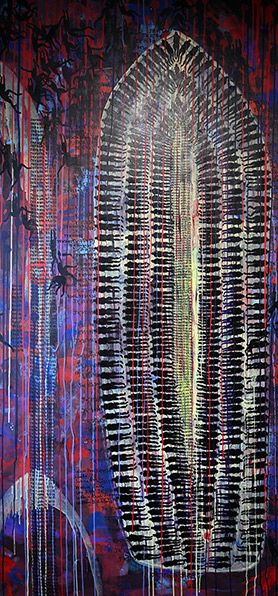
"Galleys of Souls" is a memorial on human trafficking and slavery. Now every: Black Lives Matter!!! by OtGO

Andrea Gamp
Constance – Berlin, February 2021
OtGO: Triptych The Galleys of
SoulsTranslated by: Alicia Sayell
-- The original text in German --
The Triptych The Galleys of Souls (2013-2021, acrylic on canvas, 215 x 300 cm, 215 x 400 cm, 215 x 300 cm) takes on difficult subject matter that has occupied the artist OtGO in his Berlin studio for several years, namely that of slavery and human trafficking. Despite a continuing lack of visibility and the sense of the ‘taboo’ that such topics garner in mainstream society, these once historically significant issues have become relevant again today, in times when the Black Lives Matter movement in the United States, mass waves of refugee migration in Europe, and the Corona pandemic intensify as political points of contention. In light of this, one must ask again and with much sensitivity: What do slavery and human trafficking truly mean? How is the galley penalty related to it? And in particular, how does OtGO explore these issues through his works and open them up to contemporary discourse?
First of all, a few general words about these terms, which appear to be so closely linked: Since the beginning of mankind, we have been enslaving other humans. Already in antiquity, slaves were thought of economically and by law as ‘unfree‘ and were considered the ‘possessions‘ of other people. Slavery describes this relationship of dependence and is synonymous with laborious, physically draining work. Through the millennia and into today, human trafficking involves the robbery and deportation of people – often to other countries – to be exploited for labour or sexually abused.
Slavery and human trafficking have acquired sad notoriety in world history. This is especially true of the major European maritime powers during the Age of Discovery, which spanned approximately four hundred years following the Middle Ages. First, it was the Portuguese who deported Africans as early as the first half of the 15th century. They exchanged goods for human lives on their shipping voyages and sold these people as slaves. Soon thereafter, the Spanish also engaged in the slave trade. Upon arrival in the New World, they likewise enslaved the indigenous populations of the Americas and the Caribbean. In a third stage, ships brought the raw materials obtained with such 'labour', notably cotton, tea, coffee, tobacco, sugar, and precious metals, from the colonies to Europe. Soon other colonial powers entered the 'flourishing' trade – among others: England, France, Holland, and Denmark. The result was a second wave of millions of West Africans being taken away to colonise the Americas. Only one in four survived the brutal capture and deportation – mostly by their own upper class – and the shipping across the Atlantic. Inhumane conditions prevailed on such vessels: Slaves were squeezed onto the ships, body to body, like pieces of cargo, on and below deck. They were put in chains, mistreated, and left to their uncertain fate without food or medical treatment. The seriously ill were disposed of, without delay, by being mercilessly thrown overboard. The artist OTGO has intertwined the theme of the slave-trading ships with that of the galleys, which were originally known in the ancient world as oar-driven, two-masted warships from the Mediterranean. The galley punishment as atonement meant that convicted criminals were sent to row on such ships, which subsequently often meant death under cruel conditions.
Compositionally, all three large-format paintings of the triptych The Galleys of Souls exhibit a homogeneous structure. Three hulls – and in the larger, central picture, six – are vertically positioned and of differing sizes, dominating the picture field. Although the viewer can easily identify these images as the forms of ships based on the title (galleys), an unbiased perspective, from both a distance and under the lens of abstraction, certainly allows for other ideas: Is the microcosm of organic beings on display here, such as cells and paramecia? Can the leaf structures of tropical plants be discerned on a macro level? Or more artificially thought – are we dealing with Central American fan shapes in the style of Mayan ornamentation? Or the brightly lit windows of a sacred space?
However, when approaching the pictures, details abruptly tear the viewer out of these harmless chains of associations, and one is confronted with the pictorial theme of slave ships! Upon closer inspection, these ships reveal their interior: silhouettes of bodies lined up in a doomed chain of strict order become recognisable. They are human figures but, like planks, they are forced horizontally and vertically into the shape of the ship. They represent all the human bodies that were crowded together, drastically said, like 'sardines' in the hulls of the ship. Those of them who have already left this terrible ‘order’ on the ships or have been thrown overboard, seem to fly in a wide arc over the ships or to swirl in groups through the sea. Already at this point, the idea of souls – which concerns the second part of the title – becomes understandable. This oppressive effect is reaffirmed on a more formal level by OTGO’s countless blood-red handprints smothering the canvas, and by his distinctive signature – consisting of a thumbprint and vertical lettering, this time in the same blood-red – found at the sterns of each of the ships.

In all three pictures the primary colours blue and red struggle with each other in a luminous colour palette. The background is enriched with accents of violet and azure which, through textured layering, begin to emulate a vast sea. The impressions of two-dimensionality coupled with contrasting depths of colour and tonality alternate in these pictures. Black marks the bulk of the figuration who, in endlessly long rows, form the internal structures of the ships. Others seem to 'swirl' freely in groups outside of the ship forms. Everything belonging to these figures is black: the manacles, indicated by curved lines shackling the figures together at the torso and neck, as well as the codes of letters and numbers. These lists are subtly found in the pictorial ground, in the contours of the ships, and framing individual human figures.
The third primary colour, yellow – the complementary colour of violet – is a strongly lightened nuance assigned to the inner surfaces of the galley ships. This yellow is further used for the brushstrokes that partially outline the bow or the stern of ships and then merely run out into flowing traces of colour. Are these ships that have long since sunk into the sea? Wrecks that remain visible at the water’s surface? Ghost ships? In any case, this fragmentary representation is reminiscent of them. On each canvas, an individual dab of orange marks a single patch of numerical codes and lettering creating a signalling effect, like drawing pins used to display advertisements on a notice board. At this point, it becomes clear: alongside the exploration of the motif, the act of painting as such exhibits itself as medium in this piece.
This can be experienced once again in the application of dripping paint in the same colour palette. In addition to a thin glaze, it also stretches in flowing tracks of colour like fine prison bars across the canvas. Or does the viewer see traces of blood and tears? Together with splashes of paint (especially in the third hull of the central picture), they blend over the opaque black figures, who are essential elements of the pictures. Defiguration can thus not only be read in the aforementioned 'shipwrecks', but is often caused by flow marks and splashes of paint that visually dismember the figures. Figurative superimpositions can be found in the detached groups between the ship hulls or the lined-up 'swimmers' at the stern of the last ship in the central picture. The latter are seemingly positioned to appear as if their souls have just begun to take flight diagonally across the ship.
The interpretation of a concrete pictorial event is left to the viewer because OtGO's works do not follow any scheme of narrative, pictorial storytelling. This means that the viewer has to discover the respective work, piece by piece. If they allow themselves to do so, they 'stumble' over the ambivalence in the themes of the slave ships and of the galleys in the triptych The Galleys of Souls. This is because the depiction contradicts the title when trying to make out oars on the ships, or when trying to understand the arrangement of the slave bodies displayed inside as that of oarsmen in chains. The hands of those chained together remain invisible – the limbs that symbolise freedom, as the artist suggests. Despite the omission, one is tempted to interpret some of the adjacent numbers and letters as coded oar shapes in the broadest sense. But even these codes do not reveal their secret, as they jump back and forth between anonymity and identifying labelling. The artist often uses the common Mongolian word ‘bool’ (боол) for ‘slave’. This can be seen, for example, in the middle picture between the second and third hull. Shorter lists of names then provide some variety, as in the third piece on the right edge of the canvas. These names are taken from historical figures around the world who were victims of slavery.
To determine a metamorphosis in OtGO's paintings, such as a 'change of status' to a liberated slave or a transition from life to death, the viewer searches the exhibited movement patterns and sometimes spasmodically splayed extremities of the figures outside the ships. Whether these figures actually stand for still-living swimmers, flying souls, or dancing dead cannot be determined from the depiction per se. Even without shackles, those outside the ships remain faceless silhouettes in the same colouring as their brothers and sisters on board. All together they recall the fate of slaves on such crossings, whose lives often ended unnoticed and swiftly.
In the search for art-historical and intermedial comparisons to OtGO's The Galleys of Souls, three aspects should be mentioned as examples: Firstly, if one radically detaches oneself from the subject and wishes to focus solely on figuration and colouring, Helmut Middendorf's two-part painting Electric Night (1979, distemper on untreated cotton, 200 x 300 cm, Städel Museum, Frankfurt/M.) is an option. The figures of the then ‘New Savage,’ from the Galerie am Moritzplatz in Berlin-Kreuzberg, depict dancers at night and therefore might initially appear contrary to OtGO's slave figures. However, Middendorf also designed his figures in a correspondingly minimalist manner, as dark silhouettes in a colour mixture of blue and red. Moreover, their twitching arms and legs are not unlike those of the figures outside the ships.
Secondly, if one searches for African-American objects and structural analogies in the painting, it is also worth referring to one of New York's 'scene stars' of the 1980s: the graffiti artist and close friend of Andy Warhol, Jean-Michel Basquiat (1960-1988). In the streets of SoHo he left messages under the pseudonym SAMO© (for "same old shit", the persistent racism). Similarly in his paintings, such as Irony of a Negro Policeman (1981, oil, acrylic, and coloured pencil on canvas, 122 x 183 cm, private collection, New York), writing comments on the respective subject matter. Thus, the relationship between text and image is to be discussed in his art – a circumstance that also applies to OtGO's triptych The Galleys of Souls, although the writing there (‘bool’ and other names) is both more subtle and semantically unspecific than in Basquiat's work.
Thirdly, numerous films now address slavery from different perspectives, the suffering on slave-trading ships, or the ancient galley punishment. Examples include the historical action story Harriet (2019) about the African-American freedom fighter and women's rights activist Harriet Tubman (1820-1913), Steven Spielberg's Amistad (1997), or the literary adaptation Ben Hur (2016) based on the novel by Lew Wallace, to pick just three US productions of the last twenty-five years.
Video: https://youtu.be/LIfkJebpaGo
Triptych: The Galleys of Souls –1/3 by OtGO 2013–2021, acryl on canvas 215 x 300 cm, 215 x 400 cm, 215 x 300 cm
So far these topics are 'splinters' of a large complex of themes that OtGO's triptych The Galleys of Souls touches. The aim is to raise awareness of a topic that has left deep scars in the collective memory of today's Black People of Colour – a topic that frustratingly often remains invisible or is deliberately made invisible. In order to process this artistically, there are controversial attitudes. OtGO comments on this as follows:
"A radical position is taken by Kara Walker, for example, whose oeuvre I have followed over several years. She is one of the few who have managed to draw enough attention to the subject. This may be intensified since Black Lives Matter has come into existence. Walker's large-scale drawings move the viewer emotionally. In her grotesque silhouettes, the fairytale-like depiction works against the aggressive and obscene content. Walker provokes with her installations. To denounce the British transatlantic slave trade she exhibited the installation Fons Americanus (2019-2021) at the Tate Modern Turbine Hall. The allegorical fountain is directed as an 'anti-monument' against London's Victoria Memorial."
In contrast, the painter OtGO himself wants to explore a reconciliatory dimension. According to his own statement, he sees himself as an "ambassador" who has fulfilled the task of setting up a "monument’" to these people in the medium of painting. More than that, OtGO wants to face the souls of the deceased slaves "with respect and in devotion" to finally "liberate" and "redeem" them, as he calls it. This spiritual content is underlined by the artist's formal decision in favour of the triptych – the format of time-honoured altarpieces. Conversely, it is also the artist himself who, through painting, frees himself from a motif that has weighed him down for so long.
And through this 'liberating' circumstances, OtGO feels connected to the related method of an artist who approaches the difficult chapter of slavery in an equally positive way. She is forging a new path that unites seemingly insurmountable opposites: choreographer Bintou Dembélé stages Jean-Phillipe Rameau's opéra-ballet Les Indes galantes (1735) with hip-hop dancers as a "decolonised version" in Paris in 2019. This makes her the first Black woman since in the piece was composed in the Baroque era to master this task at the prestigious Opéra Bastille in Paris! Watching her dance, it becomes clear what is meant: she updates the history of slavery through her "movements", as she also explains in an interview. She performs this to "commemorate" the "marrons", escaped plantation slaves, and to "turn the language of the oppressors". "Standing tall" is the maxim to free these people and to preserve their memory she believes. Her body creates a physical response through fluid inversions. For example, the dancer symbolically 'releases' the downtrodden utilising soft hand gestures in spiral forms upwards, over her own head 'towards heaven'. Bintou Dembélé's movements thus trace in the medium of dance for the "marronage" what OtGO's painted figures suggest in expressive gestures outside the slave ships.
In conclusion, neither the choreographer Bintou Dembélé nor the painter OtGO can rewrite the history of slavery. They can however convey it to people through their art and, as role models, promote more sensitivity and hope in today's society with their positive approach.
America wrote the abolition of slavery in 1865. But to this day, Black People of Colour there and in other countries experience the consequences of slavery in the form of racism, torture, and police violence. Child slavery in Africa, the Caribbean, and India, the flight and drowning of refugees in the Mediterranean, and human trafficking in Eastern Europe and Southeast Asia are still common phenomena in this world. This should give us food for thought, especially in the current crisis and its correlating ‘entanglements’, which necessitate us to act with courage and humanity every day.
Sources (selection)
dpr. kulturalltag. Jean-Michel Basquiat. Boom for Real (02/16/2021).
Hatje Cantz Verlag. Magazin. Künstler & Kunstlexikon. Die neuen Wilden (02/16/2021).
Homepages of the artist OtGO Otgonbayar Ershuu (16.02.2021).
i-D. black art matters: jean-michel basquiat (02/16/2021).
Jean-Michel Basquiat.com. Irony of a Negro Policeman (02/16/2021).
artist interview of OtGO with Andrea Gamp 02/05/2021, 02/12/2021, 02/18/2021 and 02/23/2021.
National Geographic. Geschichte und Kultur. Mit Revolver & Vision: Harriet Tubman riskierte ihr Leben für Sklaven (02/16/2021).
planet wissen. Sklaverei. Sklaven für Amerika (02/16/2021).
planet wissen. Schifffahrt. Vom Floß zur Kogge (02/16/2021).
Städelblog. Helmut Middendorf. Durch die Linse elektrifiziert (02/16/2021).




